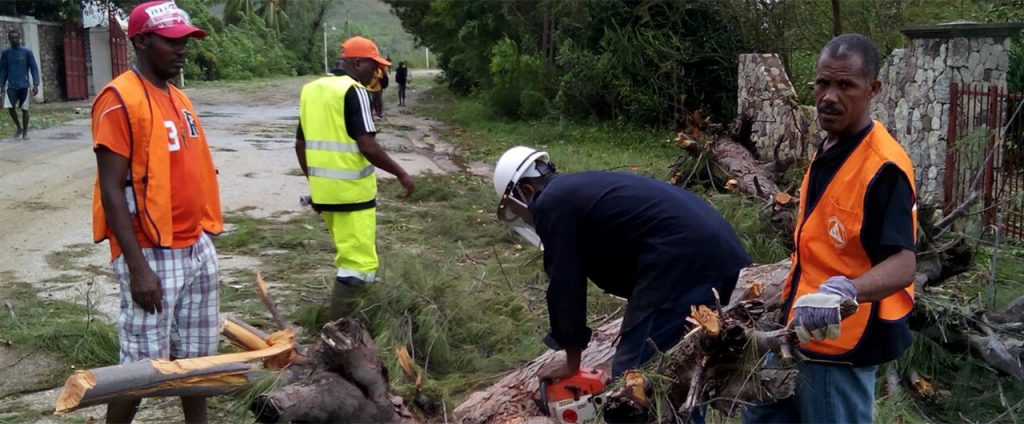It’s time for a new way to think about aid
By Ilio Durandis
CJ Contributor
When disaster strikes all masks come off. Every little problem gets magnified 10 fold. This is exactly the situation in Haiti post-Hurricane Matthew.
Immediately after the impact, the most devastated area, the southern peninsula of the country, was without any means of communication; people were left with no shelter, food, and clean water. A grave humanitarian crisis that could get even more complicated if the sanitation conditions worsen.
In the midst of the hurricane, the calls for aid were already taking place. More strikingly, all kinds of people were getting out of their way, not so much to provide relief, but more to take pictures of people and destroyed buildings. All of a sudden it became cool to turn poverty, hopelessness and misery into a slideshow.
Haiti, geographically, is situated on the path of destructive natural phenomena, more specifically earthquakes and hurricanes. Each passing natural disaster proves that the core fabric of this nation is yet to be built. The Haitian government tried to improvise a plan of evacuation of those most at risk a few hours before Matthew’s landfall.
There was no doubt that once again, Haiti was going to need major foreign aid to come to the rescue of those victimized by the hurricane. For a country like Haiti, it is not just an expectation to wait for foreign aid after a disaster, it has become the main way to respond.
Often, one of the side effects of the reliability on foreign aid is the sustainability of poverty. At this point, we need to advocate for drastic changes in how aid is distributed after a disaster and redefine the purpose of aid in general.
Humanitarian aid after a disaster, if well coordinated, can save many lives and release lots of pressure on local authorities that do not have enough resources to respond to their population’s needs. Major problems can arise when aid is not well coordinated, and when those in need are not the main beneficiaries.
It is imperative that humanitarian aid not be confused with developmental aid.
In moments of crisis, the two can often be interchanged in news reports as if they are the same thing.
Humanitarian aid is provided for a quick relief and must address a pressing need to save lives and prevent the propagation of diseases, if any arise. Developmental aid, on the other hand, is there to assist a country in building the necessary infrastructure and systems needed for sustainable development. The funds allocated for these two type of aids must not be misused.
But usually, both are needed after a major natural disaster in poor country, which is the case for Haiti.
Why does that distinction matter? If you recall, after the earthquake in 2010, lots of money was raised, and aid came pouring from all over the world to help Haiti recover. The relief effort, immediately after the quake was very good to say the least. The real struggle came when it was time to decide the ways to rebuild Haiti. In essence, the developmental aid after the quake never materialized to the point where, six years later, Haiti has no real institution capable of coordinating the relief efforts for the victims of the hurricane.
For the past six years, it seemed that Haiti was caught in the dilemma of relief/recovery versus long term sustainable development. The aesthetic pressure to remove those living in tents throughout the capital was a big priority for the Haitian government and its international partners, as the policy to build back better was centered around the attraction of foreign investment and the re-launching of the tourism industry.
Most of the money that was raised to help those who were most affected by the quake ended up in fictitious projects that did not help the country built back better — as hurricane Matthew clearly demonstrated.
The development of real national infrastructure, such as evacuation shelters equipped to meet evacuees needs for a few days, proper sanitation and potable water station, and some sort of government back insurance financial service that could protect the assets of those most vulnerable in case of natural disasters, was totally neglected.
Rethinking aid in time of disaster would allow receiving nations to clearly manage the immediate urgency and also allow them to plan for the long term, in order to better coordinate relief and recovery efforts next time a natural disaster event takes place.
The focus during the emergency relief should not be done to the detriment of local institutions and the dismissal of local authorities. Those who live among the victims are best equipped to help them during and after a natural disaster. Aid providers must trust these local actors to get the job done.
One of the reasons why aid money always seems to do little in areas impacted by a disaster is simply because it costs more to provide the aid after such disaster than it is before. For example, a plan that would cost $10 million dollars to give clean water to a town of 100,000 people might cost twice as much to provide water bottle to the same amount of people. One would provide a sustainable solution, whereas the more expensive one only provides a temporary fix. This is what can be considered the aid conundrum: Relief aid is often more costly than developmental aid.
There are many reasons why this is the case, but a simple one is the fact that it’s more convenient for donors to be involved and taken charge in quick aid distribution than it is to commit to long term aid project.
Receiving nations need to understand that it is not always wise to rely on relief aid, or that it is suicidal to govern a nation with policies that expect foreign aid to pour in when natural disaster strikes.
It would be smarter for nations like Haiti to take a hard look at their policies and their relationship with foreign donors as far as relief efforts are concerned, and conditions that are imposed on aid for development.
When a nation is able to build and invest in the necessary institutions, infrastructure and the qualified human resources it is in better position to do more with less, and besides recovery aid after a disaster is as good as a tourniquet on a badly wounded soldier. At some point, this soldier will need a full surgery, if they are to make a full recovery.
Haiti and countries in similar economic situations must implement policies that will make them better able to provide the immediate emergency response after a disaster — that way they will be in a better situation to channel the outside aid where it is needed most.
Foreign aid after a disaster should never become another disaster in itself — but the best way to prevent such situations is for the receiving nations to be in a strong position to coordinate all aid distribution within their own borders. A
nd that cannot be done if developmental aid is not properly channeled to make a country economically and politically stronger.
What poorer nations usually need after a major disaster is a great package of developmental aid, but rather the focus is often on providing them with humanitarian aid, a stop gap measure, which leaves them in perpetual need for foreign assistance.
Ilio Durandis, a Caribbean Journal contributor, studied political science at the University of Massachusetts-Lowell. He holds a masters in molecular biology. He currently serves as the Vice-Dean for the Medical Biology and Director of the Mckenna Biosciences programs at Universite Notre Dame Haiti- UDERS Hinche.







